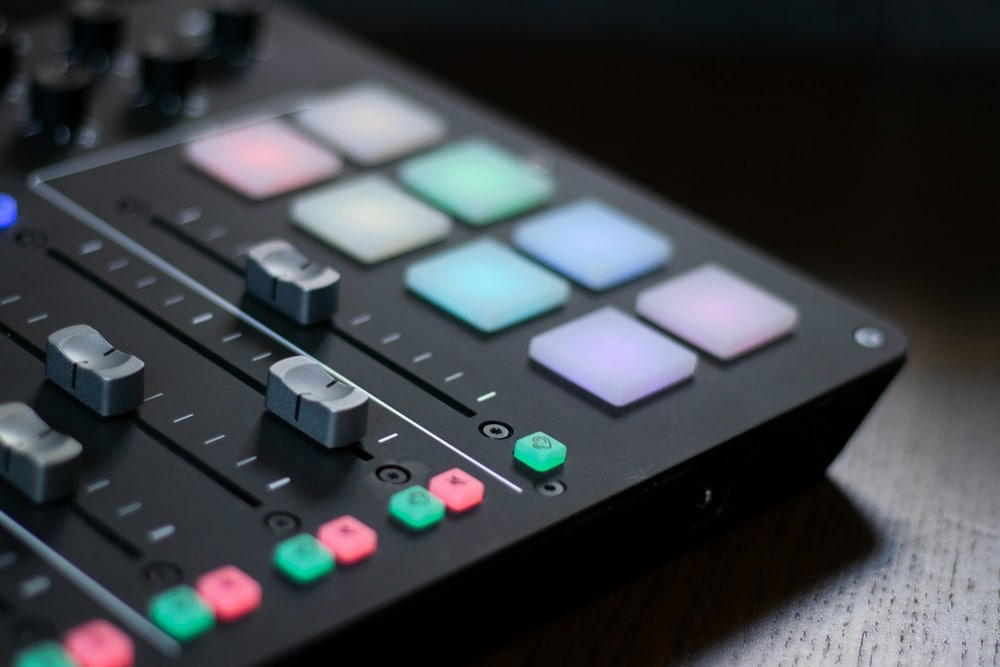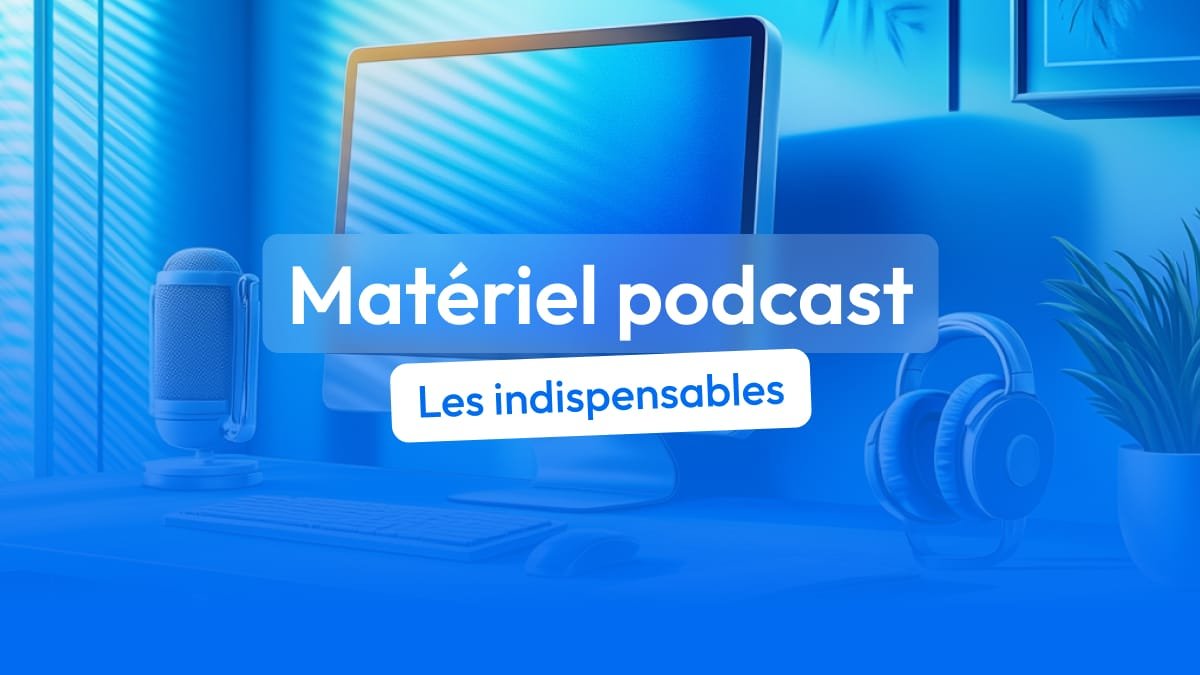You wonder what podcast equipment to buy before launching your channel? You are in the right place. Podcast microphone, podcast headphones… Here is the complete list of equipment to make a professional, quality podcast.
Whether you're a novice looking to get started with the essentials, or an enthusiast looking to perfect your studio, this article guides you on the equipment needed, from recording your podcast to publishing it.
Why buy equipment to make a podcast?
You have made the decision to publish your first podcast channel ? Very good news! But before skipping steps, you should know that investing in equipment to make a podcast is essential to guarantee professional listening quality and capture the attention of your audience. Whether you are a beginner or experienced, having good podcast equipment allows you to obtain clear sound, without parasites, and to enhance your content.
By equipping yourself with a suitable podcast microphone, comfortable podcast headphones and reliable podcast recording equipment, you ensure a smooth experience for both you and your listeners. If you want to get started with video podcasting, the right video podcast equipment will help you produce output that is both qualitative and engaging.
Beginner podcast equipment: what do you need to buy?
When you're starting out, choosing the right podcast equipment is essential to achieving clear, professional sound without breaking the bank. The minimum you need when starting your podcast channel is a quality podcast microphone, podcast headphones to properly monitor the audio, as well as simple and effective recording equipment. This basic equipment will allow you to launch your first episode in good conditions and lay the foundations for a podcast that is polished and pleasant to listen to.
Read also: 7 ideas for creating an original podcast
Equipment for making a podcast
For launch a podcast professionallysome basic equipment is mandatory. They guarantee sound quality that keeps the attention of your community by providing an enjoyable listening experience. Here is the podcast recording equipment you need before getting started.
Choosing the right podcast microphone
Professional-quality audio instantly transforms a podcast into an immersive and enjoyable experience for the listener. The microphone is therefore a central element of podcast equipment, essential to obtain a clear and faithful rendering.
For beginners, USB mics are a great entry point. Easy to install, they connect directly to your computer without requiring additional equipment. Among the most popular references, we find:
- the Blue Yeti;
- the Audio-Technica AT2020USB+;
- the Rode NT-USB.
These models strike a good balance between price, simplicity and audio quality, and deliver crisp recordings from the first episode.


For those who wish to optimize sound quality and get closer to a professional sound, XLR condenser microphones are recommended. Many models are popular with many podcasters and streamers such as:
- the Shure SM7B;
- the Rode NT1-A;
- the Heil PR40.
These microphones deliver superior audio fidelity, but require the use of an audio interface to convert the analog signal into a digital signal that can be used by the computer.
The importance of podcast headphones to capture the recording
Choosing the right podcast headset is essential for any podcaster, beginner or experienced. The reason? It allows you to monitor sound quality in real time. Unlike speakers, it provides accurate listening for vocals, background noises and any imperfections, making it easy to make immediate adjustments while recording.
It is also useful for avoiding feedback phenomena. (high-pitched whistle that occurs when a microphone picks up sound from a speaker and loops it back) or resonance that can occur when sound from the mic is bounced back into the room.


For optimal comfort during long sessions, it is recommended to choose a closed, lightweight helmet with insulating pads, such as the following models:
- Audio-Technica ATH-M50x;
- Sony MDR-7506;
- Beyerdynamic DT 770 Pro (widely used by professional podcasters).
Investing in quality headphones not only contributes to a cleaner recording, but also makes editing and mixing easier, ensuring a professional and enjoyable final result for your listeners.
Which podcast software to choose?
Between recording and editing the podcast, it is essential to choose the right podcast software. Here are the three tools most used by recognized French podcasters and studios:
Adobe Audition
The benchmark software in the audio industry, Adobe Audition offers advanced audio processing tools, such as noise reduction, dynamic correction and multi-channel editing. It is particularly appreciated for its stability and professional features. It is used by studios like Louie Media and Arte Radio.
Logic Pro, podcast software for Mac
Aimed at Mac users, Logic Pro is a powerful digital audio workstation (DAW) ideal for recording, editing and mixing podcasts. It is particularly suitable for productions requiring exceptional sound quality.
GarageBand, the free podcast software
Also for Mac, GarageBand is a free option that offers basic functionality for recording and editing podcasts. Although less advanced than Logic Pro, it remains an accessible solution for beginners.
Audacity
Free and multi-platform open-source software (Windows, Mac, Linux), Audacity is a reference software for independent podcasters. It allows audio recording, editing and editing in a simple way, with many effects and plugins available. It’s an excellent choice to get started without investment.
The magic of editing transforms raw recordings into polished works. For beginners or those needing a basic tool, Audacity is a free and simple option, perfect for basic cuts and adjustments without overwhelming the user.
GarageBand also benefits from a Mac user-friendly interface, ideal for those taking their first steps into audio editing.
In case you want monetize your podcastit is recommended to use Adobe Audition or Reaper, which both offer comprehensive features, promoting the professional rendering of your podcasts.
Podcast material too often neglected
For creators looking to take their podcast to the next level, integrating these accessories can make all the difference. While not essential to get started, they still offer significant improvements in audio control, quality and flexibility.
The articulated arm
You might think a microphone stand is a gimmick, but it's part of the basic podcast hardware. It keeps the microphone in optimal position, limits noise and ensures consistent sound quality throughout the recording, thus reducing post-production work.
For even greater efficiency, it is best to mount it on the floor or wall to minimize the transmission of vibrations from the desk.
Mixer: the audio control center


Introducing a mixer into your setup instantly elevates the production quality of your podcast. This equipment allows you to manage multiple audio sources with ease, adjusting levels and integrating effects in real time.
Whether you're coordinating multiple speakers or manipulating various audio tracks, a mixer simplifies these tasks.
Audio interface: the key to professional-quality microphones
We briefly mention it in the first part of the article, the use of XLR microphones requires an audio interface to connect the microphone to your computer. This piece of equipment is essential to fully exploit the potential of high-end microphones. It enriches your sound with quality preamps that capture a clear and detailed audio signal.
Pop filter for crisp, precise sound
Plosives, such as pronounced “p” and “t” sounds, can disrupt the recording with explosive noises. A pop filter effectively dampens these interruptions, ensuring clear, professional articulation.
Adding this little accessory can dramatically increase the quality of your vocal recordings, making the final sound smoother and more pleasant to listen to.
Acoustic insulation
The acoustics of your recording space strongly influence the quality of the voices captured by your microphones. Using a soundproofing kit, panels or noise barriers can reduce unwanted background noise and reverberations, whether you're recording with a mic, recorder or directly to your computer. This control of the sound environment is particularly useful when several participants are speaking or if the room faces a noisy street, thus guaranteeing a professional result for your podcasts.
Additional microphones
Scheduling interviews with multiple guests sometimes requires additional microphones. Having additional mics ensures that every voice is picked up with clarity and consistency. Result: you get uniform audio quality for all participants in your podcast.
You can also provide a room microphone or simply a backup microphone that records all voices. If your main microphone fails, you will still have a usable recording.
Read also: How to publish a podcast on Spotify?
Podcast material: What to remember
To launch a quality podcast, investing in basic equipment is essential: a suitable microphone, precise headphones and efficient editing software guarantee clear and pleasant sound for your listeners.
Complementary accessories, often neglected (articulated arm, pop filter, mixing desk, audio interface or acoustic insulation kit) make it possible to control the sound environment, limit parasites and optimize the final result.
After recording your podcast, work with a freelance marketing expert to boost its distribution. Post your ad for free on Codeur.com right now!
